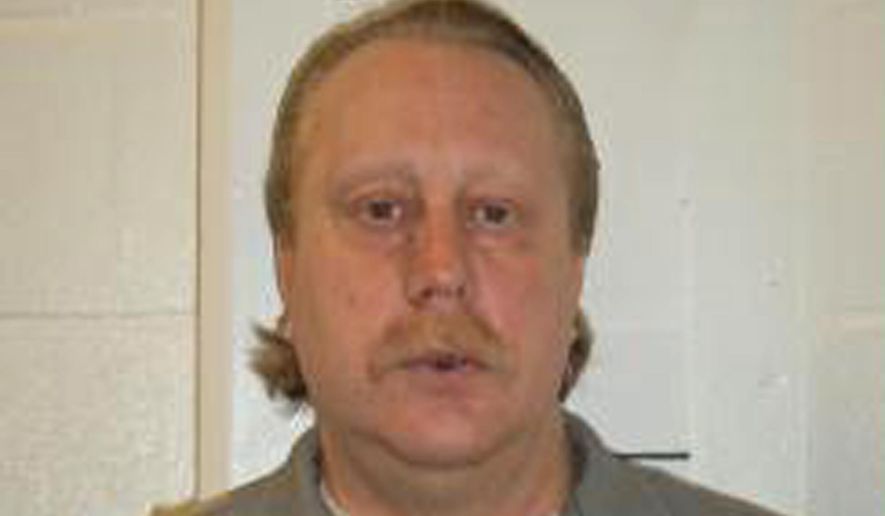The Supreme Court ruled Monday that while the Constitution says executions can’t be cruel and unusual, that doesn’t mean they have to be painless, rejecting a condemned man’s attempts to dictate his method of death.
Sharply worded opinions in the 5-4 ruling also exposed the raw nerves over the death penalty among the justices, with the minority suggesting the country is inching closer to a point where the death penalty may not be legally possible.
For now, though, the five Republican-appointed justices held sway, saying the death penalty is explicitly envisioned in the Constitution and that the Supreme Court has repeatedly ruled that it’s up to the political branches to decide whether they want to use it.
They rejected the challenge by Russell Bucklew, who was found guilty of murder and other violent crimes, and who was sentenced to death and has repeatedly challenged his execution.
His current complaint is that one of the drugs Missouri administers for its lethal injection could react badly with his rare medical condition, causing tumors in his throat to rupture and leaving him to die while choking on his own blood.
Justice Neil M. Gorsuch, writing for the majority, questioned the timing of Bucklew’s objections, the veracity of his medical claims and his suggested alternatives.
“The Eighth Amendment does not guarantee a prisoner a painless death — something that, of course, isn’t guaranteed to many people, including most victims of capital crimes,” Justice Gorsuch wrote.
Inmates such as Bucklew can challenge the method of their execution, the majority ruled, but they must show another method that the state could carry out under existing policies.
In Bucklew’s case, the alternative he suggested, using the gas chamber and nitrogen hypoxia, was not feasible. He also didn’t prove that the method would be less painful than lethal injection, the majority ruled.
The court’s four Democrat-appointed justices said Bucklew should at least have had a chance to argue his case more fully at trial.
Justice Stephen G. Breyer, writing for the main dissent, said Bucklew’s experts did suggest nitrogen might be a less painful option. Justice Breyer said Missouri should have had the burden to defend its method of execution against Bucklew’s challenge.
“Presented with evidence such as Bucklew’s, I believe a state should take at least minimal steps to determine the feasibility of the proposed alternative,” Justice Breyer wrote.
But both sides made clear that they found the case to be emblematic of overall challenges to the death penalty.
Thirty states allow execution in theory, though some of them haven’t used it in years. California has a death penalty, but Gov. Gavin Newsom, a Democrat, last month signed a moratorium on executions for the duration of his governorship.
Bucklew was convicted in 1997 of killing his ex-girlfriend’s new boyfriend, attempting to shoot his son, and raping his ex-girlfriend. While awaiting trial, he escaped from jail and beat his victim’s mother with a hammer, Justice Gorsuch said, recounting the horrific details of the convict’s crimes.
Justice Gorsuch said Bucklew exhausted appeals of his conviction more than a decade ago but has used lawsuits over the method of execution to delay his death.
“The people of Missouri, the surviving victims of Mr. Bucklew’s crimes, and others like them deserve better,” he wrote.
He went on to chide judges who cater to those kinds of lawsuits.
“Courts should police carefully against attempts to use such challenges as tools to interpose unjustified delay,” he said.
Justice Breyer fired back, saying delays are the price of making sure the ultimate penalty is carried out correctly.
“And it may be that, as our nation comes to place ever greater importance upon ensuring that we accurately identify, through procedurally fair methods, those who may lawfully be put to death, there simply is no constitutional way to implement the death penalty,” he said.
Justice Gorsuch, though, said the Supreme Court has repeatedly upheld the death penalty, it appears as an explicit penalty in the Constitution, and judges cannot be the ones to decree it unconstitutional.
“Of course, that doesn’t mean the American people must continue to use the death penalty,” he wrote. “The same Constitution that permits states to authorize capital punishment also allows them to outlaw it. But it does mean that the judiciary bears no license to end a debate reserved for the people and their representatives.”
Bucklew’s condition is known as a cavernous hemangioma that causes tumors filled with blood vessels to grow in places across the body. Bucklew suffers from tumors on his lip and mouth, as well as inside his oral cavity, which is what his legal team said complicates his execution.
He says he has to wipe off his face each morning from the blood that leaks out from his tumors overnight.
Lower courts said the lethal injection drugs would likely interfere with his airway only if they are administered while he is lying on his back — and Missouri says it can avoid that.
State experts also said the first injection in its lethal injection protocol — pentobarbital — would limit Bucklew’s pain to 30 seconds at most.
• Alex Swoyer can be reached at aswoyer@washingtontimes.com.




Please read our comment policy before commenting.